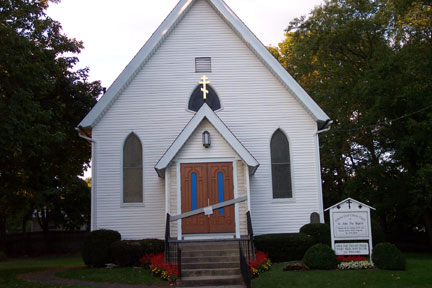Byzantine Catholic
New Britain, Hartford County, Connecticut
Orthodox
Bridgeport, Fairfield County, Connecticut
Bridgeport, Fairfield County, Connecticut
Stratford, Fairfield County, Connecticut
Byzantine Catholic
Holy Trinity Byzantine Catholic Church
New Britain, Hartford County, Connecticut
Courtesy of Rev. Frank Hanincik, Pastor & Christina Brundage
An Historical Retrospective & Photos
At the end of the Nineteenth century, as the number of immigrants from the Carpatho-Rusyn region of central Europe to New Britain began to increase, efforts were undertaken to establish a Greek Catholic parish in the city. Finally, in 1900 the parish was formally organized through the zealous efforts of the Rev. Eugene Volkay, pastor of St. John the Baptist Greek Catholic Church in the Bridgeport, CT. Father Volkay began regular visits to New Britain to minister to these faithful and to serve regular Liturgies at Sacred Heart Polish (Roman Catholic) parochial school through the courtesy of the Rev. Lucian Bojnowski. As the number of parishioners grew, Father Theodore Stefan was appointed as the first resident pastor in 1901. Through his efforts, a small wood-framed church was built on Beaver Street, at the site of the present church.
After a difficult period of struggle within the parish, Father Volkay returned as pastor when two new Greek Catholic parishes were formed, based along ethnic lines. These were St. Mary Church, now St. Mary Ukrainian Orthodox Church on Winter Street, and Holy Trinity, now reorganized as Holy Trinity Hungaro-Russian Greek Catholic Church on June 27, 1909. Holy Trinity was struck with a second tragic loss toward the end of 1909 when the church building burned. The parishioners rallied together and built another small wooden church in 1910 on the same site to replace it.
As more Greek Catholic faithful were drawn to New Britain both from Europe and from other Carpatho-Rusyn communities in the United States by the manufacturing jobs available in the area, the parish began to gather sufficient resources to rebuild the church on a larger and grander scale. With the advent of Father Ivan Romza and the collective efforts of the faithful, the present structure of steel and brick was built at the cost of $125,000 in the year 1928. It was designed by the Hartford architect Frederic C. Teich and raised by the Harry J. Battistoni Construction Company of New Britain. The Rambusch Company of New York executed the stained glass and rose windows. The parish at last could worship in a beautiful and permanent church building.
Throughout the difficult years of the Great Depression, the parish struggled to meet its financial obligations. With a sincere faith and love for God and His Church, the founders used every means to keep the parish in tact. Many mortgaged their own homes so that the church would not be lost. Father Ivan was reassigned in 1932 and was followed by Father Michael Krivonyak who diligently administered the parish.
With a scarcity of priests in the Eparchy following the departure of Father Michael in 1939, it became necessary that the pastor of St. John the Baptist Church in Bridgeport again serve the needs of Holy Trinity Church. Through the sacrifices of Father Daniel Mackov and through his conscientious efforts, the parish grew spiritually and materially.
In October of 1940, his brother, Father Alexander P. Mackov who served the parish for thirteen years, the longest of any pastor, replaced Father Daniel. Father Alexander was much loved and fervently worked to unite the parish. During his pastorate, the mortgage was liquidated in March of 1946, thanks to generosity and sacrifice of the parishioners. Additional alterations and repairs were also made at this time to the front façade of the church adding to its beauty.
Father Ivan Tylawsky was assigned to Holy Trinity in 1953. He undertook, with much labor and devotion, the redecoration of the church interior during his two-year tenure. The D’Ambrosio Ecclesiastical Art Studio of New York City was contracted to execute this project. A solemn rededication of the church followed.
Father Stephen Luzetsky came to Holy Trinity in December of 1955. He ministered to the growing needs of the parish. He helped to establish parish fraternal organizations and undertook the remodeling of the parish hall and kitchen. He made Holy Trinity better known in the community and did much to acquaint others with the rich liturgical tradition of the parish.
He was followed by Father, now Monsignor Robert Moneta. During Msgr. Moneta’s pastorate, plans were drawn and construction was begun on a new rectory. Monsignor was transferred prior to completion of this project and it became the task of Msgr. John Kallok to finish construction of and to furnish the new rectory. In spite of sickness, Msgr. Kallok reached this goal and new rectory was dedicated in 1963. During this time, the Byzantine Franciscan Friars from New Canaan helped with administration of the parish. In 1969, Father Benjamin Worlinsky was assigned as assistant pastor. Father Eugene Fulton arrived as the parish’s second assistant pastor in 1970. He was made pastor in 1971 upon Msgr. Kallok’s retirement.
During Father Gene’s tenure, the parish began plans for the 75th anniversary of its founding. The church was updated and an iconostasis was installed. Additional updates and repairs were made to the church. Upon Father Gene’s departure in 1977, Father John Cigan was appointed pastor. In 1979, Father Richard Klopf arrived as pastor. He also did much to foster Holy Trinity’s outreach and involvement in the community of New Britain and beyond. His untimely death in 1989 was a loss to the parish. Father Michael Kerestes served from 1989-1992. During this time, the pastor of Holy Trinity Church also began to administer St. Michael the Archangel Church in South Hadley, MA. Father Constantine Brown served for an interim period followed by Father Alan Kapron. Father Alan also did much to spiritually renew the parish. The exterior of the church was re-pointed and sealed during his pastorate and a fully appointed chapel was constructed in the basement of the rectory for weekday Liturgies.
Father Robert Woytek became pastor in August of 1998. Upon his arrival a Centennial Committee was formed to begin plans to celebrate the parish’s 100th anniversary on Pentecost Sunday, 2000. Three specific areas were chosen as special projects as part of the centennial year preparation. The parking lot was resurfaced and sidewalks repaired, the electrical wiring in the sanctuary and nave of the church was replaced and updated, and lastly the interior of the church would be cleaned and repainted. A large range of activities was scheduled as both fundraising and social or religious events. These included brunches and dinners, a concert by the world renowned Yale Russian Chorus, a super tag sale, and the annual Slavic bazaar. The culmination of the year was the centennial weekend celebration on June 10 & 11, 2000. On Saturday, June 10th, the All Souls Liturgy was celebrated in the Church followed by a Panachida at the parish cemetery to remember the founders of parish who sleep there. In the afternoon, Great Vespers for Pentecost were served, followed by a wine and cheese reception in the church hall. Finally, on Sunday, June 11 at 3:00PM, Bishop Andrew and the current and former pastors served the Solemn Divine Liturgy of Pentecost. A dinner reception followed at The Hawthorne Inn in Berlin, CT.
The momentum raised by the preparations for the Centennial has not ended with conclusion of the festivities. The committee has been renamed and has moved on to formulate long-range goals for the parish and for future growth. A gardening group has been formed to maintain and beautify the grounds, thereby enriching the entire Beaver St. neighborhood. Plans are underway to make the church handicap accessible and to make needed repairs and updates to the rectory. Lastly, on June 19, 2000, the newly created Holy Trinity website on the World Wide Web expanded the boundaries of the parish out into cyberspace, making the us known throughout the whole world.
Holy Trinity parish is most grateful to God for all the blessings that He has showered upon us over the past 100 years. With our eyes fixed on God and His plan for us, we move forward with renewed commitment to begin the next 100 years of faith and service to Him and all His people.
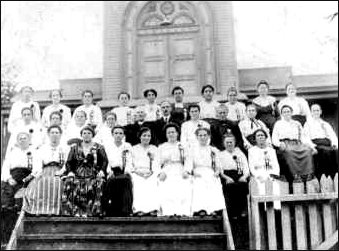
Women's Society circa 1910 - Father John Hrabar, pastor
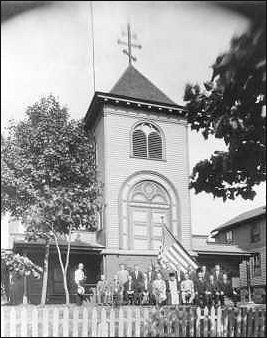
Church committee circa 1920's
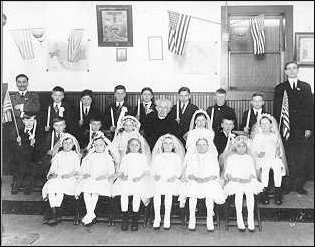
1st Communion Class of 1917-Father Michael Bisaha, pastor
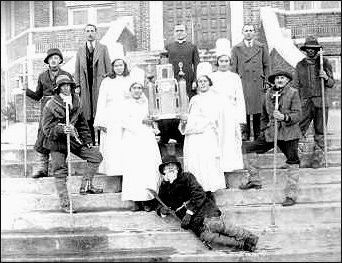
Bethlehem carolers in front of church 1929 - Father Ivan Romza, Pastor
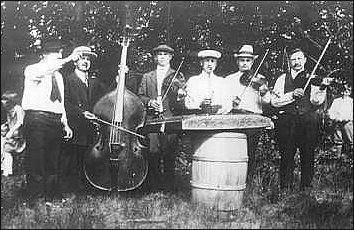
Band playing at Hostyna in the churchyard after dedication of the new church 1929
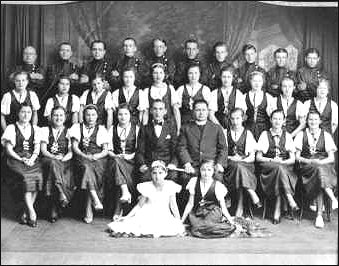
Church choir circa 1934/35 - Father Michael Krivonyak, Pastor; Prof. George Remecki, Cantor
Orthodox
Holy Ghost Russian Orthodox Greek Catholic Church
Bridgeport, Fairfield County, Connecticut
History
Original Church - Hallett Street
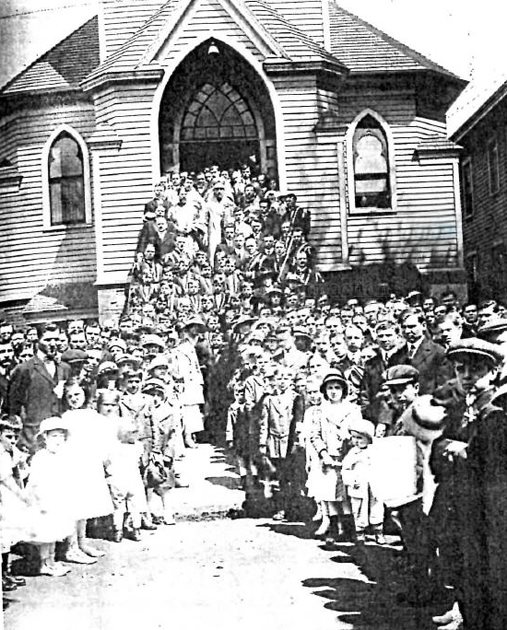
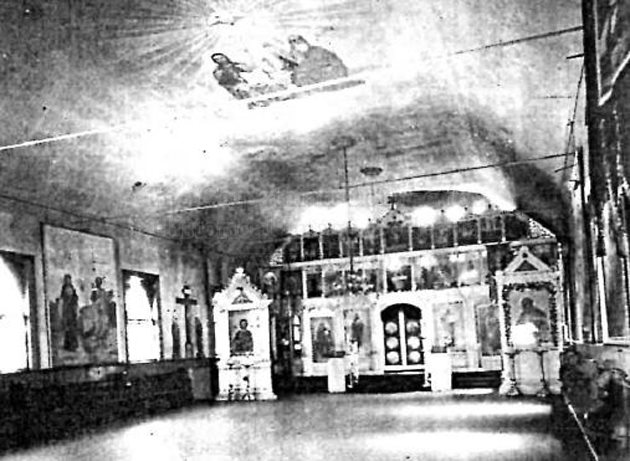
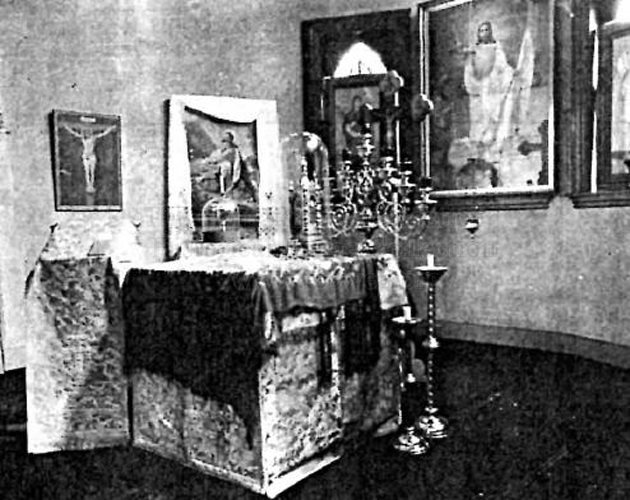
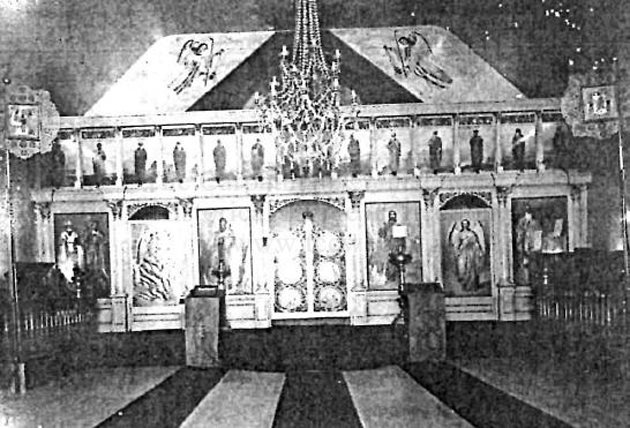
Thousands of immigrants came to the United States during the 19th and the early 20th century. The reasons for immigration were numerous. Many came to find religious freedom, some to secure better economic conditions and others, to leave lands that were plagued by war and strife. Due to the industrial nature of Bridgeport, numerous immigrants chose to settle in this town due to the abundance of work. A group of immigrants gathered to discuss plans for a church so that they could worship their faith. These immigrants had been Greek Catholic but upon their entrance into the United States decided they no longer wished to be affiliated with Rome and passed a resolution to apply to the Orthodox jurisdiction. A group of these individuals met with Father Alexis Toth who was called the "Father of Russian America" (and who later was canonized as St. Alexis of Wilkes-Barre in 1994). This was how the formation of Holy Ghost Orthodox Church began.

In 1894 a group of future parishioners met with Bishop Nicholas of San Francisco, Bishop of the North American Archdiocese of the Orthodox Church in America and with Father Alexis Toth to explore the founding of a new church. This group met twice and on September 25, 1894 Bishop Nicholas offered an Archpastoral letter fully accepted these members into Orthodoxy. The original founding date of Holy Ghost was October 20, 1894. Funds were collected and members worked to build the new church. It is to the credit of these immigrant founders that in the span of only six short months, Holy Ghost was completed. The dedication of the new church was held on Palm Sunday, April 26, 1895 with Father Alexis Toth offering the first Divine Liturgy. During the year 1896 Bishop Nicholas asked Mr. Makara to travel to Russia to request funding for this new Orthodox Church. Mr. Makara received an audience with Emperor Nicholas II of Russia and the Emperor was gracious to his request. A donation of six magnificent bells had been cast for the coronation of the Emperor in 1896 and Nicholas II offered these to the new church. Upon entrance to the United States a problem developed which almost stopped Holy Ghost from receiving this gift. The bells were detained by United States customs officials for payment of a large import duty. Many members and those who supported Holy Ghost protested. In light of this, President William McKinley singed a special bill that had been introduced in the 55th session of the United States Congress, which permitted these bells to be brought to Holy Ghost, duty free.
The history of these bells is very interesting. The largest bell offers a raised relief of the former Emperor Nicholas II and his wife, the Empress Alexandra. This bell weighs approximately 4,000 pounds and on the opposite side of the bell are icons of the Savior. Two of the smaller bells contain reliefs of St. Alexandra and St. Nicholas, the patrons of the Emperor and Empress. The bells were cast by the renowned metallurgist, B.M. Orlov of St. Petersburg, Russia. Tonal production was a secret but was produced in part with such metals as copper, brass, silver, bronze and other alloys. Unfortunately, this well guarded secret of Imperial Russia is now lost. The way in which bells were constructed to produce the sterling tones for which bells in Russia are known is now gone. With the breakup and disbanding of various foundries during the revolution this art was lost forever.
The gift of these bells was not only generous but historical as well. Very few churches in America have such a set of bells that were offered by a reigning Russian monarch during this period. Holy Ghost Orthodox Church is the mother church of Orthodoxy in New England and in the Bridgeport areas. Many early immigrants from Orthodox lands such as Romania, Greece, Serbia and Albania attended services until they were financially able to build their own houses of worship. Holy Ghost was truly an all-encompassing Orthodox church due to the many heritages that worshiped there for many years. The church offers an extensive history due to the diligent records kept by Father Nicholas Vasilieff. His records show he traveled throughout Connecticut to perform services and offer the sacraments to those who had no Orthodox church. Connecticut was not his only area of service and his records show he traveled to places as far away as Massachusetts and Providence, Rhode Island.
Holy Ghost continued during these years to grow and expand at a very fast pace. The influx of new immigrants from Eastern Europe and those who wished to leave the Greek Catholic church and return to the Orthodox Church swelled the membership. The church grew so large that a new church was necessary. On Palm Sunday, April 26, 1937 a larger church was built on its present site. Holy Ghost has been the recipient of many honors during her long history. On June 13, 1981, the church was rededicated with the sealing of the relics of St. Herman of Alaska. These relics were brought by His Grace, Bishop Gregory of Sitka, Alaska that replaced the missing relics of St. Barbara. In 1994 the 100th Anniversary of Holy Ghost Orthodox church was celebrated. Father Alexis Toth who in 1894 assisted the original immigrant members to build this church was warmly remembered for his assistance to Holy Ghost. The highest honor bestowed on Holy Ghost was the fact that the first Divine Liturgy celebrated for this parish was offered by Father Alexis Toth, now known as St. Alexis of Wilkes-Barre.
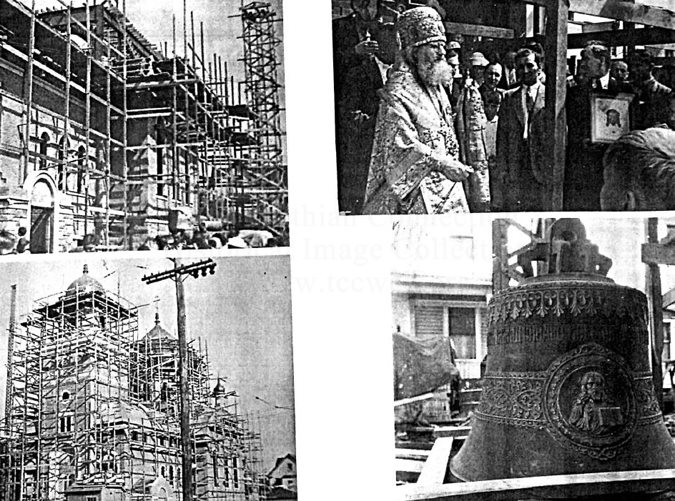
Holy Ghost is not only a church of grace and architectural beauty but the interior decorations are magnificent. The stained glass frescos depict the major feasts of the church and are breathtaking. The Stained Glass Association of America in 1983 conducted a survey of stained glass in America. Two of those assisting the association for this survey were Lydia and Alexander Garasimowicz. This survey added to its data base information on Holy Ghost’s stained-glass windows which are located at the University of Massachusetts and is available to art historians for their research. Other works of art to be seen at Holy Ghost are an icon of St. Seraphim of Sarov (in a kiosk), which was hand painted on Mount Athos, Greece by the monks. Gifts of four icons in 1896 were offered from the Imperial House of Romanoff which depict the Theotokos holding the infant Jesus, Christ the Savior, St. Nicholas, St. Alexandra and Saints Cyril and Methodius. The painting method of the icons is in Italian style as during this period it was popular and these are located on the Iconostasis.
1969 Committees and Organizations
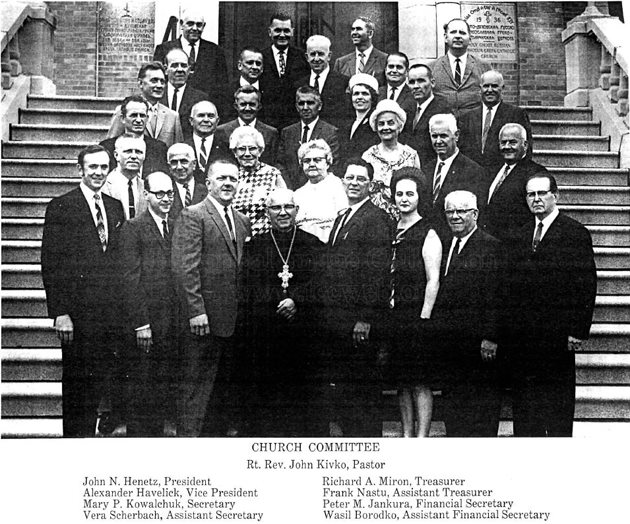
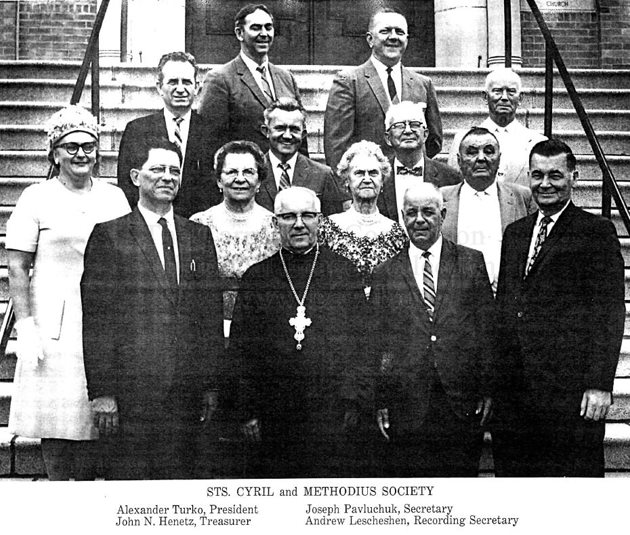
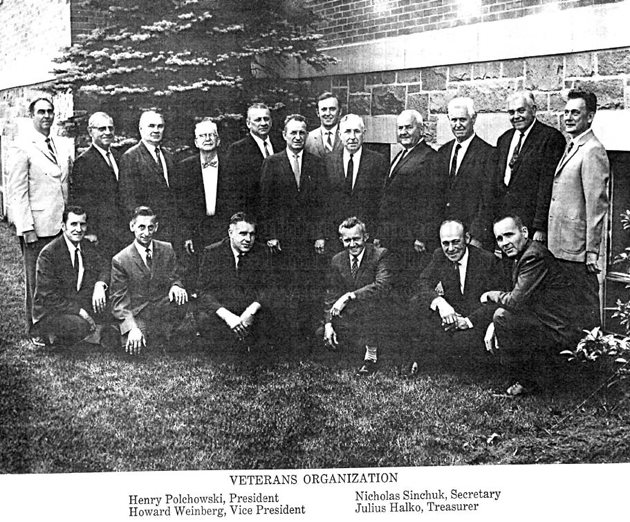
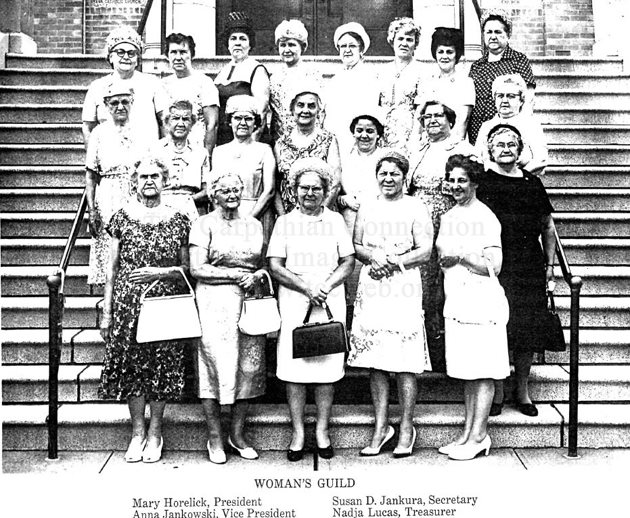
St. John the Baptist Carpatho-Russian Orthodox Greek Catholic Church
Bridgeport, Fairfield County, Connecticut
History
Photos Courtesy of Joy E. Kovalycsik & Steven M. Osifchin
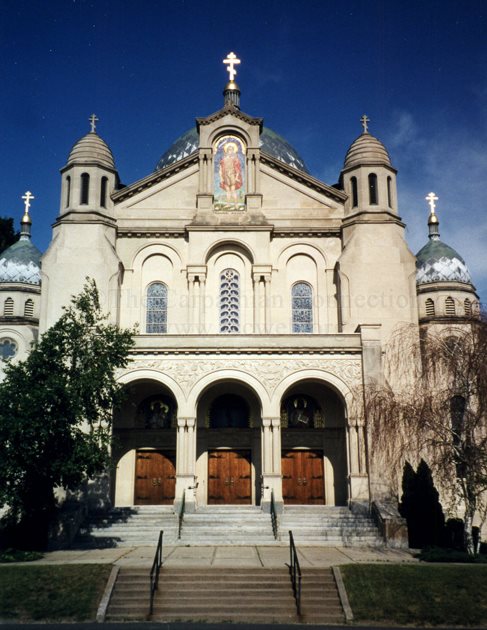
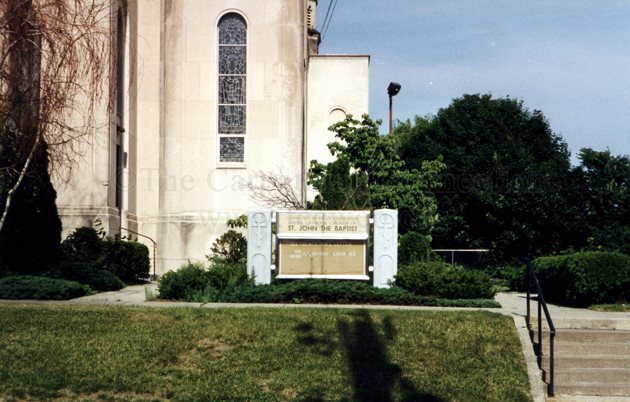
In 1880 the first group of Carpatho-Russian immigrants began to settle in Bridgeport, Connecticut. Many of these immigrants came from the Carpathian territories of Austria-Hungary, Poland and the interior regions of Hungary. Being a people with no established country, these Carpatho-Russians held fast to their language, traditions and religious practices. A group of these Carpatho-Russians came to the east side of the industrial city of Bridgeport to start new lives. These pious and hardworking individuals wished for a church to worship God in their own faith. After much discussion, this small congregation began to hold services in a rented store located at Pembroke and Hallam Streets. The Reverend Eugene Volkay was their first priest but could not remain with them for a long period. The members purchased property on Arctic Street near Hallet Street and 1907 saw the beginning of Saint John’s. The Reverend Orestes P. Chornock was installed as pastor in 1911 and would remain with the members until March of 1947. One problem which did become serious was ecclesiastical affiliation. Loyalties were divided between those who adhered to Rome and were called "Uniates" and by those who recognized the jurisdiction of the Russian Orthodox church. These were strained times as many members knew their faith was eastern rather than western in ritual, rites, customs and traditions. In the 1920's Bishop Basil Takach arrived in America and visited Bridgeport in 1924. His agenda was to enforce Romes will in reference to the celibacy issue within the Greek Catholic Church. His explanation was that married priests were a source of envy to the Latin Rite Roman clergy and therefore, the Greek Catholic church would have to conform. The years that followed were difficult and very trying. In time though, it would become a period of new religious freedom for people who wished to remain in their faith and retain their cherished traditions.
The Bridgeport church stood fast to defend the right of the married clergy among other traditions. St. John’s joined forces with other churches headed by the Russian Greek Catholic Brotherhood. This brotherhood was a fraternal society located in Homestead, Pennsylvania and commonly called the "Sojedinenija." During this turmoil, Rome suspended several priests who were raising their voices in protest of the unjust treatment their faith was receiving. Reverend Fathers Orestes Chornock, Stephen Varzaly, Peter Molchany, Ireney Dolhy and John Soroka were included in this suspension. Various church congresses were held in Pittsburgh during the years 1932 and 1934 to appeal to Rome for justice and reconsideration. Rome refused and on November 23, 1937 a Congress of Churches was held in Pittsburgh. This congress severed all relations with the Roman Catholic Church and nominated Father Orestes Chornock as its bishop-nominee. In Constantinople, Father Chornock was consecrated a bishop on September 18, 1938 and was installed two months later. During this time a group of Uniates and the Roman Catholic church instituted a civil suit to gain control of the church property. A census of members was taken and 99% donated money for the legal defense fund. Finally, due to Rome’s unlimited financial resources and connections, the church property was lost. The loyal members did not give up at first but fought bravely to the end. The case was advanced through every legal avenue which culminated in the Supreme Court of the United States.
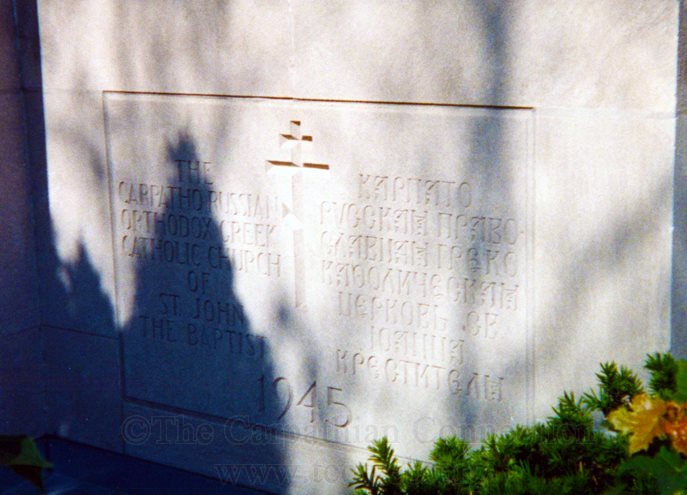
The Supreme Court denied the members their property and on October 14, 1944 a new church was brought into existence. Incorporation papers were singed in Bridgeport, Connecticut on December 8, 1941. During this period, services for the members were held in the Armenian Church of the Holy Ascension on Barnum Avenue. In late 1944, members gathered to plan the building of a new church. These individuals were overjoyed that they would again have a house of worship and gave what they had, and more, to accomplish this task. On December 13, 1944 at 11:55 a.m. the ground-breaking ceremony was held. This simple service offered that they had not been trampled down but in reality, had been the victors. These members are to be commended for what they did to build this church. Since the new congregation could not obtain bank loans, the members themselves paid for everything which was a monumental task given the period of time they were living in. It is almost unbelievable that after the first announcement to collect funds and at the conclusion of two weeks the gigantic sum of $200,000 was secured. Final purchases were made which included the land and property located at 348-358 Mill Hill Avenue. The purchase included a home which later would be remodeled to serve as a seminary for the new jurisdiction. The dedication of the new church was held on June 2, 1946. Father Joseph G. Simko of Warren, Ohio was called to be the first pastor of Saint John’s. The first liturgy was served with great happiness on March 29, 1947. The parishioners thought they would finally be left in peace and yet, another civil suit was instituted to try and obtain this new property. This time, those who wished to destroy the new church were entirely defeated. The Superior Court of Connecticut rendered a decision that all properties owned by the new jurisdiction were owned by St. John’s. The decision also rebuked the Catholic bishop from further interference into their personal property affairs.
After many years of upheavals and struggle, the church began to grow and prosper. The loyal parishioners who were devoted to their church erased the $500,000 debt within ten short years. It was at this time that a new project was begun. The interior decorations were to be expanded and renovated as this was deemed necessary. The first artist arrived at St. John’s on January 21, 1956. The work continued and no cost was spared to make this house of worship magnificent. Finally, on Sunday, July 12, 1959, the interior work was fully completed. Along with this project the parishioners also approved having the exterior cleaned and waterproofed to protect the interior. Liturgical observances were not overlooked and a new Plaschenica was purchased along with new carpeting for the entire church. Many renovations, upgrades and expansions were instituted at the church during various points in time to keep the church in good repair. In 1974 the brilliant stained glass windows were completely restored and repaired at a cost of $25,000. Always mindful of who owned and paid for this church a Benevolent Fund was established in November, 1981 to aid parishioners in need and during financial emergencies. During the second renovation held in the 1980's icons were cleaned and repainted, the entire electrical and sound systems were updated and the entire exterior and interior were again cleaned. The total cost for the second renovation was approximately $300,000. The icons found in this church are radiant. Christ With The Children and The Entry Into Jerusalem are works of art. They are simple in design yet, stunning in their makeup. The dome mural of The Creation which shows God creating the Earth is inspiring. The main altar itself is priceless. A magnificent tabernacle rests upon the altar which offers a carving of the Last Supper. The tabernacle is a scaled-down model of an entire church and the attention to detail on this tabernacle is majestic. The exterior of the church is simply gorgeous. The frontal view of the church shows a large main dome graced by a golden three bar cross. Four smaller domes adorn the frontal view and the architecture is fascinating. In the middle of two domes is an indentation with the icon of St. John the Baptist. This church can be seen many blocks away due to its size. The sandstone color of the church exterior is a lovely contrast to the green domes which rest on top of the church. The entrance to the church is located under a main portal. Three sets of massive wooden doors are welcoming. Above each set of doors are icons which should not be overlooked. The corner stone of the church reads: "The Carpatho-Russian Orthodox Greek Catholic Church of Saint John the Baptist" in both English, and Cyrillic. The cornerstone is dated 1945. St. John’s has experienced a magnificent history. The parishioners of this exquisite church have contributed much with their accomplishments and especially during periods of trouble and turmoil. For all those who choose to drive up Mill Hill Avenue, just viewing this church is a credit to these pious and devoted parishioners. Their true sense of self-sacrifice to honor God and their faith is a testament for all to emulate.
St. John's Russian Greek Catholic Cemetery and Chapel
Photos Courtesy of Steven Osifchin & Joy E. Kovalycsik
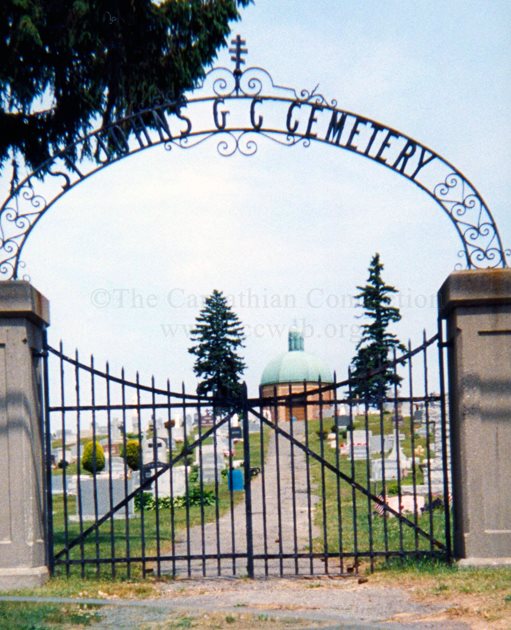
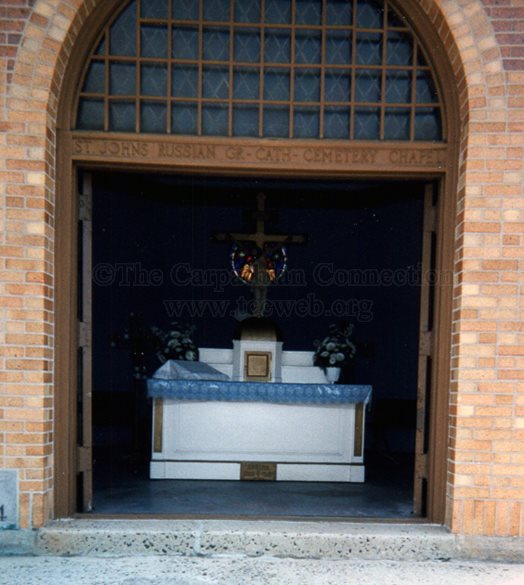
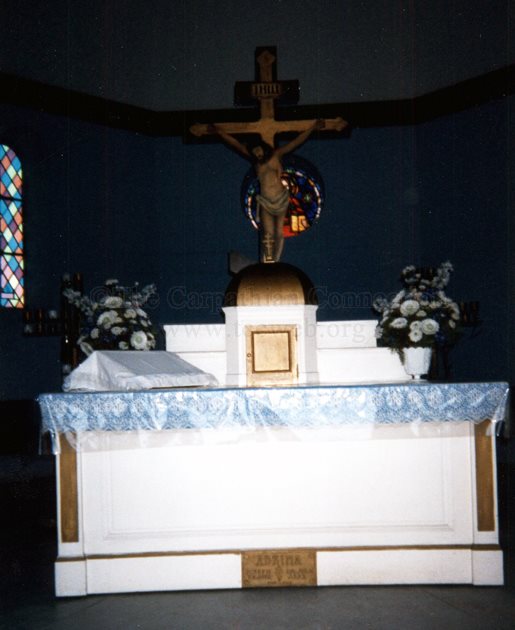
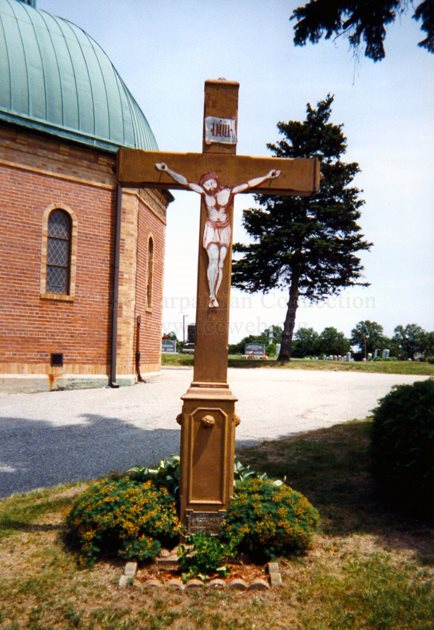
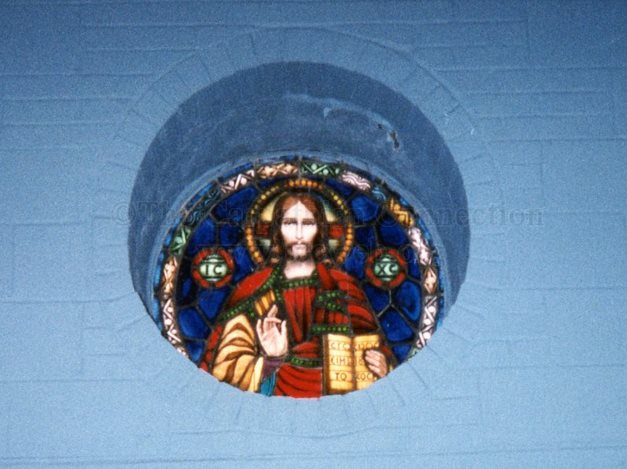
St. John the Baptist Orthodox Church
Stratford, Fairfield County, Connecticut
TCC wishes to extend a special thank you to Father Peter Paproski for offering the history and photos of his parish.
History
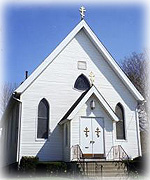
Welcome to Saint John The Baptist Orthodox Church, (The Orthodox Greek Catholic Church of Saint John The Baptist). We are a parish of the Orthodox Christian Faith which was established on the day of Holy Pentecost in the Year 33 AD. Our parish community is a member of the American Carpatho-Russian Orthodox Diocese of the U.S.A. whose presiding bishop is His Eminence, Most-Reverend Metropolitan Nicholas. The American Carpatho-Russian Orthodox Diocese is an autonomous diocese under the spiritual protection of the Ecumenical Patriarchate of Constantinople of which His All-Holiness, Ecumenical Patriarch Bartholomew I is the Primate.
While the founding members of our parish community emigrated from the Carpatho-Rusyn region of present day Slovakia and Western Ukraine, our present ethnic composition is mixed. Although a large percentage of the parish is of Carpatho-Rusyn descent, there are also people of Italian, German, English, Irish, Ukrainian and other ethnic backgrounds. Our parish community has been in existence for over ninety years, having been instrumental in the erection of two beautiful church edifices in the City of Bridgeport, which are still in existence today. Our community has been worshipping in its present location in Stratford for over fifty years.
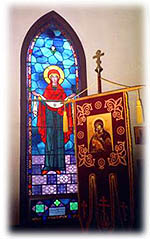 Our parish community holds firmly to the traditions and beliefs of our Holy Orthodox Christian Faith as passed down to us from our forefathers. We are a small, but growing , active family-oriented parish with a approximately 100 parishioners. Building on the strong foundation of faith instilled in us by our ancestors, we are committed to sharing the Holy Orthodox Christian Faith we love so dearly, with all who seek it. We welcome you to our parish web site and hope you enjoy your on-line visit. We cordially invite you to personally visit our parish when you are in the Stratford, Connecticut area.
Our parish community holds firmly to the traditions and beliefs of our Holy Orthodox Christian Faith as passed down to us from our forefathers. We are a small, but growing , active family-oriented parish with a approximately 100 parishioners. Building on the strong foundation of faith instilled in us by our ancestors, we are committed to sharing the Holy Orthodox Christian Faith we love so dearly, with all who seek it. We welcome you to our parish web site and hope you enjoy your on-line visit. We cordially invite you to personally visit our parish when you are in the Stratford, Connecticut area.
Church Sign
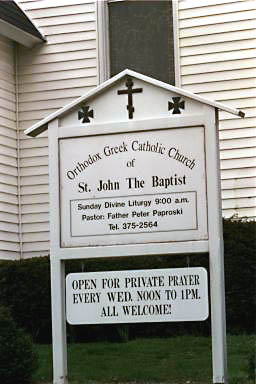
Iconostasis During Pascha 1999
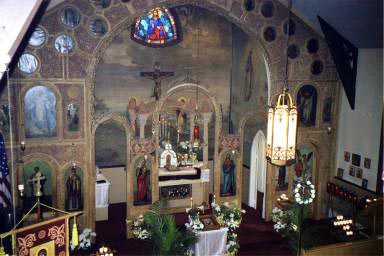
In 2004 a second prayer shrine was erected on the church property. Master craftsman Frank Meyernick, fashioned the cross out of cedar wood. On Sunday, October 16, following Divine Liturgy, Fr. Peter blessed the cross as the faithfull sang the Troparion to the Cross.
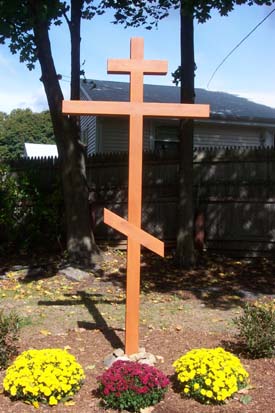
In September 2006 new Church doors were installed. The were donated in memory of the Franco and Witiak Families. Marcel Breton, of Breton Construction, assisted by parishioner and master carpenter, Frank Meyernick installed the new doors. The project was overseen by "Parish Facilities Manager" Tom Decerbo.
